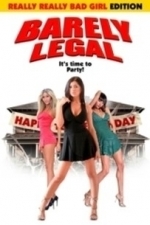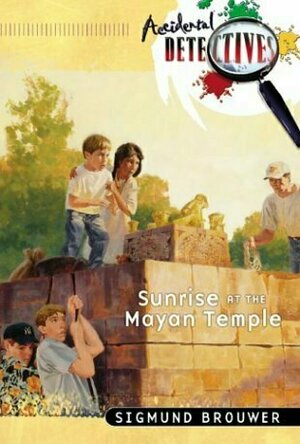Search

The Salt House
Book
In the tradition of Jodi Picoult and Lisa Genova, this gorgeously written, heartbreaking, yet...
Fiction drama

Before We Were Yours
Book
Memphis, 1939. Twelve-year-old Rill Foss and her four younger siblings live a magical life aboard...
Historical fiction
Mark @ Carstairs Considers (2346 KP) rated Sunrise at the Mayan Temple in Books
May 18, 2020
Slow Start, Fast Paced Second Half
Ricky Kidd is surprised when his younger brother, Joel, is given six tickets to spend 10 days down in Mexico. He’s even more surprised when his parents agree to send the two of them plus his friend Mike, Ralphy, and Lisa, along with Old Lady Bugsby as their chaperon, down there. When the group arrives, they learn they are there to be part of a dig at Chichen Itza. It sounds great, but Ricky soon begins to get new worries. Like why is everyone afraid of the leader of their dig? Are the rumors of an ancient legend come back to life true? Or is something more sinister happening?
Normally, I love this series, but this is definitely the weakest book. The mystery starts slowly with a travelogue as Ricky and the gang head south. Once the plot does begin, it moves quickly, but Ricky has to have much of it explained to him at the end. He does have a few insights, but not the usual ones that solve the case. The short story used to introduce the plot also causes some issues with the book overall, ignoring some of Ricky’s drive for justice we’d normally see. It twists the broader story instead of just introducing it. Fortunately, the characters are as wonderful as always, and I enjoy spending time with them. It also has some funny moments, including a great running gag. If you are already a fan, you’ll want to pick up this book, but if you are new to the characters, start with one of the earlier, better ones.
Normally, I love this series, but this is definitely the weakest book. The mystery starts slowly with a travelogue as Ricky and the gang head south. Once the plot does begin, it moves quickly, but Ricky has to have much of it explained to him at the end. He does have a few insights, but not the usual ones that solve the case. The short story used to introduce the plot also causes some issues with the book overall, ignoring some of Ricky’s drive for justice we’d normally see. It twists the broader story instead of just introducing it. Fortunately, the characters are as wonderful as always, and I enjoy spending time with them. It also has some funny moments, including a great running gag. If you are already a fan, you’ll want to pick up this book, but if you are new to the characters, start with one of the earlier, better ones.
Bob Mann (459 KP) rated The Hate U Give (2018) in Movies
Sep 28, 2021
It’s a turf war on a global scale.
I saw this as part of a “Secret Cinema” event by Cineworld cinemas in the UK. That’s where you go to see a pre-release movie without knowing what it is going to be. It’s an interesting litmus test for a) a movie’s upfront marketing appeal (how many people get up and walk out when the BBFC title appears) and b) the “grab ’em early” appeal of the movie itself (how many people get up and walk out during the first 20 minutes of so).
I’m afraid this movie didn’t do very well on either a) or b) at my showing: about 20 people left immediately, and more tellingly about another 20 people left in the first half hour. There’s a reason for that: the first half hour of this film is goddamn awful!
Starr Carter (Amandla Stenberg) is a sixteen year-old resident of Garden Heights, a black neighbourhood in a US city, where she lives with her younger brother and step-brother. Their parents Maverick (Russell Hornsby, “Fences“) and Lisa (Regina Hall) are devoting all of their energies to “break the cycle” and get their kids out of the neighbourhood and off to college and better futures. As such, the kids attend not the rough-house local school but a much more upper-class establishment: there Starr has to play a different role, with links to her origins being kept hidden even from her white boyfriend Chris (K.J. Apa).
But all that changes when her boyhood friend Khalil (Algee Smith) is shot and killed in a police stop-and-search. As the only witness, and with Khalil linked to local gang lord King (Anthony Mackie), Starr’s anonymous world is about to get a national focus shone onto it.
Man… I hate voiceovers in films and always have. So I really hated the start of this film which has Starr narrating ABSOLUTELY EVERYTHING (“Blah, blah, blah..”): no audience discovery is required. It also starts with a sort of highschool romance vibe, but not one that’s well done with kissing (“Blah, blah, blah..”) while the local Mean Girls look on (“Blah, blah”) then with Starr’s friends trying to act street (“blah, blah”) while Starr tries not to be street, all to the constant droning of Starr’s voiceover (“Blah, blah, blah..”). (I never walk out of movies…. but I can kind of understand the rationale of those who did).
Fortunately the voiceover then largely recedes (it only pops up with occasional staccato “thoughts”, before storming back for a “blah, blah” finale). And with the shooting, the film takes on a much more interesting slant, giving Amandla Stenberg a chance to really shine.
I have commented on Ms Stenberg before: she was the only really good thing in the recent “The Darkest Minds“. Here she exhibits a tremendous range from the delighted (her smile is radiant and seems astonishingly unforced) to the heartbroken and furious. There’s also a really strong supporting cast with great turns from Hornsby, Hall, Mackie and Smith. Hornsby in particular I found great as the Dad desperately tutoring his kids in military (but loving) fashion to avoid his mistakes.
For me, this seemed to be a surprisingly atypical view of a black ghetto-living family. A scene set in a diner is genuinely touching at emphasising the loving and close-knit nature of the Carter family.
Where I will struggle here is in trying to interpret my overall feelings about the film. As a white, older male person I have three degrees of separation from Starr’s perspective. And these are undoubtedly difficult issues to juggle with. The riots that happened recently in towns like Ferguson ape the activities on screen uncomfortably. Your sympathies might lie to some degree with the unfortunate white police officer (Drew Starkey); sympathies supported by the views of Starr’s police officer uncle Carlos (Common): until Starr points out via a punchy question that you REALLY shouldn’t feel like that… and your views are brought up with a jolt.
Aside from the rights and wrongs of the incident, there’s a frustrating dichotomy at play in the film with black and white communities wanting to be treated equally but never wanting to be treated the same. “You don’t SEE me” wails Starr. “I see you” replies Chris (as if James Cameron was directing!) But does he really? Without colour, I do not consider myself to be remotely capable of fully understanding Starr’s perspective on life. It made me want to read the source novel by Angie Thomas to try to get better insight.
Directed by George Tillman Jr., it’s undoubtedly a mixed bag, but I came down in the end on the side of it being good rather than bad… it has certainly had me thinking for a couple of days. The clumsy voiceovers and story elements in the opening and closing scenes mask a number of parallel and interesting story strands that generate conflicting thoughts about the state of race relations in today’s America. Jackson sang “It doesn’t matter if you’re black or white”: and it really shouldn’t, but actually in some quarters, it clearly still does.
I’m afraid this movie didn’t do very well on either a) or b) at my showing: about 20 people left immediately, and more tellingly about another 20 people left in the first half hour. There’s a reason for that: the first half hour of this film is goddamn awful!
Starr Carter (Amandla Stenberg) is a sixteen year-old resident of Garden Heights, a black neighbourhood in a US city, where she lives with her younger brother and step-brother. Their parents Maverick (Russell Hornsby, “Fences“) and Lisa (Regina Hall) are devoting all of their energies to “break the cycle” and get their kids out of the neighbourhood and off to college and better futures. As such, the kids attend not the rough-house local school but a much more upper-class establishment: there Starr has to play a different role, with links to her origins being kept hidden even from her white boyfriend Chris (K.J. Apa).
But all that changes when her boyhood friend Khalil (Algee Smith) is shot and killed in a police stop-and-search. As the only witness, and with Khalil linked to local gang lord King (Anthony Mackie), Starr’s anonymous world is about to get a national focus shone onto it.
Man… I hate voiceovers in films and always have. So I really hated the start of this film which has Starr narrating ABSOLUTELY EVERYTHING (“Blah, blah, blah..”): no audience discovery is required. It also starts with a sort of highschool romance vibe, but not one that’s well done with kissing (“Blah, blah, blah..”) while the local Mean Girls look on (“Blah, blah”) then with Starr’s friends trying to act street (“blah, blah”) while Starr tries not to be street, all to the constant droning of Starr’s voiceover (“Blah, blah, blah..”). (I never walk out of movies…. but I can kind of understand the rationale of those who did).
Fortunately the voiceover then largely recedes (it only pops up with occasional staccato “thoughts”, before storming back for a “blah, blah” finale). And with the shooting, the film takes on a much more interesting slant, giving Amandla Stenberg a chance to really shine.
I have commented on Ms Stenberg before: she was the only really good thing in the recent “The Darkest Minds“. Here she exhibits a tremendous range from the delighted (her smile is radiant and seems astonishingly unforced) to the heartbroken and furious. There’s also a really strong supporting cast with great turns from Hornsby, Hall, Mackie and Smith. Hornsby in particular I found great as the Dad desperately tutoring his kids in military (but loving) fashion to avoid his mistakes.
For me, this seemed to be a surprisingly atypical view of a black ghetto-living family. A scene set in a diner is genuinely touching at emphasising the loving and close-knit nature of the Carter family.
Where I will struggle here is in trying to interpret my overall feelings about the film. As a white, older male person I have three degrees of separation from Starr’s perspective. And these are undoubtedly difficult issues to juggle with. The riots that happened recently in towns like Ferguson ape the activities on screen uncomfortably. Your sympathies might lie to some degree with the unfortunate white police officer (Drew Starkey); sympathies supported by the views of Starr’s police officer uncle Carlos (Common): until Starr points out via a punchy question that you REALLY shouldn’t feel like that… and your views are brought up with a jolt.
Aside from the rights and wrongs of the incident, there’s a frustrating dichotomy at play in the film with black and white communities wanting to be treated equally but never wanting to be treated the same. “You don’t SEE me” wails Starr. “I see you” replies Chris (as if James Cameron was directing!) But does he really? Without colour, I do not consider myself to be remotely capable of fully understanding Starr’s perspective on life. It made me want to read the source novel by Angie Thomas to try to get better insight.
Directed by George Tillman Jr., it’s undoubtedly a mixed bag, but I came down in the end on the side of it being good rather than bad… it has certainly had me thinking for a couple of days. The clumsy voiceovers and story elements in the opening and closing scenes mask a number of parallel and interesting story strands that generate conflicting thoughts about the state of race relations in today’s America. Jackson sang “It doesn’t matter if you’re black or white”: and it really shouldn’t, but actually in some quarters, it clearly still does.
Bob Mann (459 KP) rated Mary Poppins Returns (2018) in Movies
Sep 28, 2021
A valiant attempt to recreate a masterpiece.
How do you repaint a masterpiece: the Mona Lisa of children’s fantasy cinema? Some would say “You shouldn’t try”.
As I’ve said before, Mary Poppins was the first film I saw when it came out (or soon afterwards) at a very impressionable age…. I was said to have bawled my eyes out with “THE MAGIC NANNY IS GOING AWAY!!” as Julie Andrews floated off! So as my last cinema trip of 2018 I went to see this sequel, 54 years after the original, with a sense of dread. I’m relieved to say that although the film has its flaws it’s by no means the disaster I envisaged.
The plot
It’s a fairly lightweight story. Now all grown up, young Michael from the original film (Ben Whishaw) has his own family. His troubles though come not singly but in battalions since not only is he grieving a recent loss but he is also about to be evicted from 17 Cherry Tree Lane. Help is at hand in that his father, George Banks, had shares with the Fidelity Fiduciary Bank. But despite their best efforts neither he, his sister Jane (Emily Mortimer) nor their chirpy “strike a light” lamplighter friend Jack (Lin-Manuel Miranda) can find the all-important share certificates. With the deadline from bank manager Wilkins (Colin Firth) approaching, it’s fortuitous that Mary Poppins (Emily Blunt) drops in to look after the Banks children – John (Nathanael Saleh), Anabel (Pixie Davies) and Georgie (Joel Dawson) – in her own inimitable fashion.
Songs that are more Meh-ry Poppins
I know musical taste is very personal. My biggest problem with the film though was that the songs by Marc Shaiman were, to me, on the lacklustre side. Only one jumped out and struck me: the jaunty vaudeville number “A Cover is not the Book”. Elsewhere they were – to me – unmemorable and nowhere near as catchy as those of “The Greatest Showman“. (What amplified this for me was having some of the classic Sherman-brothers themes woven into the soundtrack that just made me realise what I was missing!) Richard M Sherman – now 90 – was credited with “Music Consultant” but I wonder how much input he actually had?
The other flaws
Another issue I had with the film was that it just tried WAAYYY too hard to tick off the key attributes of the original:
‘Mary in the mirror’ – check
‘Bottomless carpet bag’ – check
‘Initial fun in the nursery’ – check
‘Quirky trip to a cartoon land’ – check
‘Dance on the ceiling with a quirky relative’ – check
‘Chirpy chimney sweeps’ – check (“Er… Mr Marshall… we couldn’t get chimney sweeps… will lamplighters do?” “Yeah, good enough”)
Another thing that struck me about the film – particularly as a film aimed at kids – is just how long it is. At 2 hours and 10 minutes it’s a bladder-testing experience for adults let alone younger children. (It’s worth noting that this is still 9 minutes shorter than the original, but back in the 60’s we had FAR fewer options to be stimulated by entertainment and our attention spans were – I think – much longer as a result!)
What it does get right
But with this whinging aside, the film does get a number of things spit-spot on.
Emily Blunt is near perfection as Poppins. (In the interests of balance my wife found her bizarrely clipped accent very grating, but I suspect P.L. Travers would have approved!). Broadway star Lin-Manuel Miranda also does a good job as Jack, although you wonder whether the ‘society of cockney actors’ must again be in a big grump about the casting! I found Emily Mortimer just delightful as the grown-up Jane, although Ben Whishaw‘s Michael didn’t particularly connect with me.
Almost unrecognisable was David Warner as the now wheelchair-bound Admiral Boom. His first mate is none other than Jim Norton of “Father Ted” Bishop Brennan fame (thanks to my daughter Jenn for pointing that one out)!
Also watch out (I’d largely missed it before I realised!) for a nice pavement cameo by Karen Dotrice, the original Jane, asking directions to number 19 Cherry Tree Lane.
What the film also gets right is to implement the old-school animation of the “Jolly Holidays” segment of the original. That’s a really smart move. Filmed at Shepperton Studios in London, this is once again a great advert for Britain’s film technicians. The London sets and the costumes (by the great Sandy Powell) are just superb.
Some cameo cherries on the cake
Finally, the aces in the hole are the two cameos near the end of the film. And they would have been lovely surprises as well since neither name appears in the opening credits. It’s therefore a CRYING SHAME that they chose to let the cat out of the bag in the trailer (BLOODY MARKETING EXECS!). In case you haven’t seen the trailer, I won’t spoil it for you here. But as a magical movie experience the first of those cameos moved me close to tears. He also delivers a hum-dinger of a plot twist that is a genuinely welcome crossover from the first film.
Final Thoughts
Rob Marshall directs, and with a pretty impossible task he delivers an end-product that, while it didn’t completely thrill me, did well not to trash my delicate hopes and dreams either. Having just listened to Kermode and Mayo’s review (and it seems that Mark Kermode places Poppins on a similar pedestal to me) the songs (and therefore the “Place Where Lost Things Go” song) just didn’t resonate with me in the same way, and so, unlike Kermode, I mentally never bridged the gap to safely enjoying it.
But what we all think is secondary. Because if some three or four year old out there gets a similarly lifelong love of the cinema by watching this, then that’s all that matters.
As I’ve said before, Mary Poppins was the first film I saw when it came out (or soon afterwards) at a very impressionable age…. I was said to have bawled my eyes out with “THE MAGIC NANNY IS GOING AWAY!!” as Julie Andrews floated off! So as my last cinema trip of 2018 I went to see this sequel, 54 years after the original, with a sense of dread. I’m relieved to say that although the film has its flaws it’s by no means the disaster I envisaged.
The plot
It’s a fairly lightweight story. Now all grown up, young Michael from the original film (Ben Whishaw) has his own family. His troubles though come not singly but in battalions since not only is he grieving a recent loss but he is also about to be evicted from 17 Cherry Tree Lane. Help is at hand in that his father, George Banks, had shares with the Fidelity Fiduciary Bank. But despite their best efforts neither he, his sister Jane (Emily Mortimer) nor their chirpy “strike a light” lamplighter friend Jack (Lin-Manuel Miranda) can find the all-important share certificates. With the deadline from bank manager Wilkins (Colin Firth) approaching, it’s fortuitous that Mary Poppins (Emily Blunt) drops in to look after the Banks children – John (Nathanael Saleh), Anabel (Pixie Davies) and Georgie (Joel Dawson) – in her own inimitable fashion.
Songs that are more Meh-ry Poppins
I know musical taste is very personal. My biggest problem with the film though was that the songs by Marc Shaiman were, to me, on the lacklustre side. Only one jumped out and struck me: the jaunty vaudeville number “A Cover is not the Book”. Elsewhere they were – to me – unmemorable and nowhere near as catchy as those of “The Greatest Showman“. (What amplified this for me was having some of the classic Sherman-brothers themes woven into the soundtrack that just made me realise what I was missing!) Richard M Sherman – now 90 – was credited with “Music Consultant” but I wonder how much input he actually had?
The other flaws
Another issue I had with the film was that it just tried WAAYYY too hard to tick off the key attributes of the original:
‘Mary in the mirror’ – check
‘Bottomless carpet bag’ – check
‘Initial fun in the nursery’ – check
‘Quirky trip to a cartoon land’ – check
‘Dance on the ceiling with a quirky relative’ – check
‘Chirpy chimney sweeps’ – check (“Er… Mr Marshall… we couldn’t get chimney sweeps… will lamplighters do?” “Yeah, good enough”)
Another thing that struck me about the film – particularly as a film aimed at kids – is just how long it is. At 2 hours and 10 minutes it’s a bladder-testing experience for adults let alone younger children. (It’s worth noting that this is still 9 minutes shorter than the original, but back in the 60’s we had FAR fewer options to be stimulated by entertainment and our attention spans were – I think – much longer as a result!)
What it does get right
But with this whinging aside, the film does get a number of things spit-spot on.
Emily Blunt is near perfection as Poppins. (In the interests of balance my wife found her bizarrely clipped accent very grating, but I suspect P.L. Travers would have approved!). Broadway star Lin-Manuel Miranda also does a good job as Jack, although you wonder whether the ‘society of cockney actors’ must again be in a big grump about the casting! I found Emily Mortimer just delightful as the grown-up Jane, although Ben Whishaw‘s Michael didn’t particularly connect with me.
Almost unrecognisable was David Warner as the now wheelchair-bound Admiral Boom. His first mate is none other than Jim Norton of “Father Ted” Bishop Brennan fame (thanks to my daughter Jenn for pointing that one out)!
Also watch out (I’d largely missed it before I realised!) for a nice pavement cameo by Karen Dotrice, the original Jane, asking directions to number 19 Cherry Tree Lane.
What the film also gets right is to implement the old-school animation of the “Jolly Holidays” segment of the original. That’s a really smart move. Filmed at Shepperton Studios in London, this is once again a great advert for Britain’s film technicians. The London sets and the costumes (by the great Sandy Powell) are just superb.
Some cameo cherries on the cake
Finally, the aces in the hole are the two cameos near the end of the film. And they would have been lovely surprises as well since neither name appears in the opening credits. It’s therefore a CRYING SHAME that they chose to let the cat out of the bag in the trailer (BLOODY MARKETING EXECS!). In case you haven’t seen the trailer, I won’t spoil it for you here. But as a magical movie experience the first of those cameos moved me close to tears. He also delivers a hum-dinger of a plot twist that is a genuinely welcome crossover from the first film.
Final Thoughts
Rob Marshall directs, and with a pretty impossible task he delivers an end-product that, while it didn’t completely thrill me, did well not to trash my delicate hopes and dreams either. Having just listened to Kermode and Mayo’s review (and it seems that Mark Kermode places Poppins on a similar pedestal to me) the songs (and therefore the “Place Where Lost Things Go” song) just didn’t resonate with me in the same way, and so, unlike Kermode, I mentally never bridged the gap to safely enjoying it.
But what we all think is secondary. Because if some three or four year old out there gets a similarly lifelong love of the cinema by watching this, then that’s all that matters.
Bob Mann (459 KP) rated Roma (2018) in Movies
Sep 28, 2021
“Siempre estamos solas”
Alfonso Cuarón‘s “Roma” has been lauded with praise and award’s hype, and I must admit to have been a little bit snooty about it. A black-and-white Spanish language film with subtitles that – to be honest – looks a bit dreary: can it really be that good? Having now (finally) seen it on Netflix I can confirm that’s a big YES from my point of view. It’s a novelty of a glacially slow film that grips like a vice.
A primer on 70’s Mexican History.
This is a film about ordinary life set against tumultuous times. Set in the Colonia Roma district of Mexico City (if you were puzzled, as I was, where the title came from) it is an “Upstairs, Downstairs” tale of Cleo (Yalitza Aparicio), a maid and nanny to a middle class family in the early 70’s.
There are two intertwined stories here: Cleo’s personal story and that of the family background in which she works.
Cleo has a pleasant enough life working as partners in crime in the household with Adela (Nancy García García). Life is about getting the work done (well, more of less), keeping the four children happy – to who she is devoted – and scraping enough by to spend her downtime with her martial arts boyfriend Ramón (José Manuel Guerrero Mendoza).
Meanwhile the lady of the house Senora Sofia (Marina de Tavira) has an affluent and cosseted lifestyle amid her loving family.
But times are about to change for all of the players, as events – not just the events of the ‘Mexican Dirty War’ of 1971 going on in the background – transpire to change all their lives forever.
A masterclass in framing.
It’s criminal that I wasn’t able to get to see this in the cinema. Since every frame of this movie is a masterpiece of detail. There is just so much going on that your eyes dart this way and that, and you could probably watch it five times and see more. Even the opening titles are mesmerising, as the cobbled floor becomes a screen and an airliner lazily flies across it.
Even major action sequences, that other directors would fill the screen with (“Do you KNOW how much this scene is costing for God’s sake??”), are seen as they would typically be seen in real life – second hand, from a place of hiding. This is typified by the depiction of the Corpus Christi Massacre of June ’71, where the military, and more controversially the elite El Halconazo (The Hawks) of the Mexican army, turned on a student protest. Most of the action is seen as glimpses through the windows by the characters during a shopping trip to the second floor of a department store. How this was enacted and directed is a mystery to me, but it works just brilliantly.
A masterclass in pacing and panning.
One of Cuarón’s trademarks is the long take (think “Children of Men”) and here he (literally!) goes to town with the technique. An incredibly impressive scene has Cleo and Adela running through the streets of the City to meet their lovers at the cinema. It’s a continuous pan that again defies belief in the brilliance of its execution.
Even the mundane act of Cleo tidying up the apartment is done with a glorious slow pan around the room. Some of this panning is done to set the mood for the film (“Get settled in… this is going to be a long haul”) but others manage to evoke a sense of rising dread, an example at the beach being a brilliant case in point.
The cinematography was supposed to have been done by the great Emmanuel Lubezki, but he was unavailable so Cuarón did it himself! And it’s quite brilliant. So, that’s a lesson learned then that will reduce the budget for next time!
A personal story.
Cuarón wrote the script. Of course he did… it’s his story! He’s the same age as I am, so was nine years old for the autobiographical events featured in the film (he is the kid who gets punished for eavesdropping). Numerous aspects of the film are from his own childhood, including the fact that his younger brother kept spookily coming out with things that he’d done in his past lives! It’s a painful true story of his upbringing and of the life of Liboria Rodríguez: “Libo” to whom the film is dedicated.
Where the script is delightful is in never destroying the mood with lengthy exposition. Both of the key stories evolve slowly and only gradually do you work out what’s really going on. This is grown-up cinema at its finest.
It’s also a love letter from Cuarón to the cinema of his youth, a passion that sparked his eventual career. We see a number of trips to the local fleapit, and in one cute scene we seen a clip from the Gregory Peck space epic “Marooned”: the film that inspired Cuarón’s own masterpiece “Gravity“.
A naturalistic cast.
Casting a large proportion of the cast from unknowns feels like a great risk, but its a risk that pays off handsomely, particularly in the case of Yalitza Aparicio, who is breathtakingly naturalistic. Cuarón withheld the script from his cast, so some of the “acting” is not acting at all – specifically a gruelling and heartrending scene featuring Cleo later in the film. That’s real and raw emotion on the screen.
Marina de Tavira, although an actress with a track record, is also mightily impressive as the beleaguered and troubled wife.
Final Thoughts.
This is a masterpiece, and thoroughly deserves the “Best Picture” awards it has been getting. It’s certainly my odds on favourite, as well as being my pick, for the Oscar on Sunday. Will it be for everyone? Probably not.
There are some scenes which feel slightly ostentatious. A forest fire scene is brilliantly done (“Put out the small fires kids”), but then a guy in a monster suit pulls off his head-wear and starts singing a long and mournful song. Sorry?
There will also be many I suspect who will find the leisurely pace of the film excruciating; “JUST GET ON WITH IT” I hear them yelling at the screen. But if you give it the time and let it soak in, then you WILL be moved and you WILL remember the film long after you’ve seen it.
I remain cross however that this was released through Netflix. This is a film that deserves a full and widespread cinema release in 70mm format. It’s like taking an iPhone snap of the Mona Lisa and putting the phone on display instead.
A primer on 70’s Mexican History.
This is a film about ordinary life set against tumultuous times. Set in the Colonia Roma district of Mexico City (if you were puzzled, as I was, where the title came from) it is an “Upstairs, Downstairs” tale of Cleo (Yalitza Aparicio), a maid and nanny to a middle class family in the early 70’s.
There are two intertwined stories here: Cleo’s personal story and that of the family background in which she works.
Cleo has a pleasant enough life working as partners in crime in the household with Adela (Nancy García García). Life is about getting the work done (well, more of less), keeping the four children happy – to who she is devoted – and scraping enough by to spend her downtime with her martial arts boyfriend Ramón (José Manuel Guerrero Mendoza).
Meanwhile the lady of the house Senora Sofia (Marina de Tavira) has an affluent and cosseted lifestyle amid her loving family.
But times are about to change for all of the players, as events – not just the events of the ‘Mexican Dirty War’ of 1971 going on in the background – transpire to change all their lives forever.
A masterclass in framing.
It’s criminal that I wasn’t able to get to see this in the cinema. Since every frame of this movie is a masterpiece of detail. There is just so much going on that your eyes dart this way and that, and you could probably watch it five times and see more. Even the opening titles are mesmerising, as the cobbled floor becomes a screen and an airliner lazily flies across it.
Even major action sequences, that other directors would fill the screen with (“Do you KNOW how much this scene is costing for God’s sake??”), are seen as they would typically be seen in real life – second hand, from a place of hiding. This is typified by the depiction of the Corpus Christi Massacre of June ’71, where the military, and more controversially the elite El Halconazo (The Hawks) of the Mexican army, turned on a student protest. Most of the action is seen as glimpses through the windows by the characters during a shopping trip to the second floor of a department store. How this was enacted and directed is a mystery to me, but it works just brilliantly.
A masterclass in pacing and panning.
One of Cuarón’s trademarks is the long take (think “Children of Men”) and here he (literally!) goes to town with the technique. An incredibly impressive scene has Cleo and Adela running through the streets of the City to meet their lovers at the cinema. It’s a continuous pan that again defies belief in the brilliance of its execution.
Even the mundane act of Cleo tidying up the apartment is done with a glorious slow pan around the room. Some of this panning is done to set the mood for the film (“Get settled in… this is going to be a long haul”) but others manage to evoke a sense of rising dread, an example at the beach being a brilliant case in point.
The cinematography was supposed to have been done by the great Emmanuel Lubezki, but he was unavailable so Cuarón did it himself! And it’s quite brilliant. So, that’s a lesson learned then that will reduce the budget for next time!
A personal story.
Cuarón wrote the script. Of course he did… it’s his story! He’s the same age as I am, so was nine years old for the autobiographical events featured in the film (he is the kid who gets punished for eavesdropping). Numerous aspects of the film are from his own childhood, including the fact that his younger brother kept spookily coming out with things that he’d done in his past lives! It’s a painful true story of his upbringing and of the life of Liboria Rodríguez: “Libo” to whom the film is dedicated.
Where the script is delightful is in never destroying the mood with lengthy exposition. Both of the key stories evolve slowly and only gradually do you work out what’s really going on. This is grown-up cinema at its finest.
It’s also a love letter from Cuarón to the cinema of his youth, a passion that sparked his eventual career. We see a number of trips to the local fleapit, and in one cute scene we seen a clip from the Gregory Peck space epic “Marooned”: the film that inspired Cuarón’s own masterpiece “Gravity“.
A naturalistic cast.
Casting a large proportion of the cast from unknowns feels like a great risk, but its a risk that pays off handsomely, particularly in the case of Yalitza Aparicio, who is breathtakingly naturalistic. Cuarón withheld the script from his cast, so some of the “acting” is not acting at all – specifically a gruelling and heartrending scene featuring Cleo later in the film. That’s real and raw emotion on the screen.
Marina de Tavira, although an actress with a track record, is also mightily impressive as the beleaguered and troubled wife.
Final Thoughts.
This is a masterpiece, and thoroughly deserves the “Best Picture” awards it has been getting. It’s certainly my odds on favourite, as well as being my pick, for the Oscar on Sunday. Will it be for everyone? Probably not.
There are some scenes which feel slightly ostentatious. A forest fire scene is brilliantly done (“Put out the small fires kids”), but then a guy in a monster suit pulls off his head-wear and starts singing a long and mournful song. Sorry?
There will also be many I suspect who will find the leisurely pace of the film excruciating; “JUST GET ON WITH IT” I hear them yelling at the screen. But if you give it the time and let it soak in, then you WILL be moved and you WILL remember the film long after you’ve seen it.
I remain cross however that this was released through Netflix. This is a film that deserves a full and widespread cinema release in 70mm format. It’s like taking an iPhone snap of the Mona Lisa and putting the phone on display instead.






